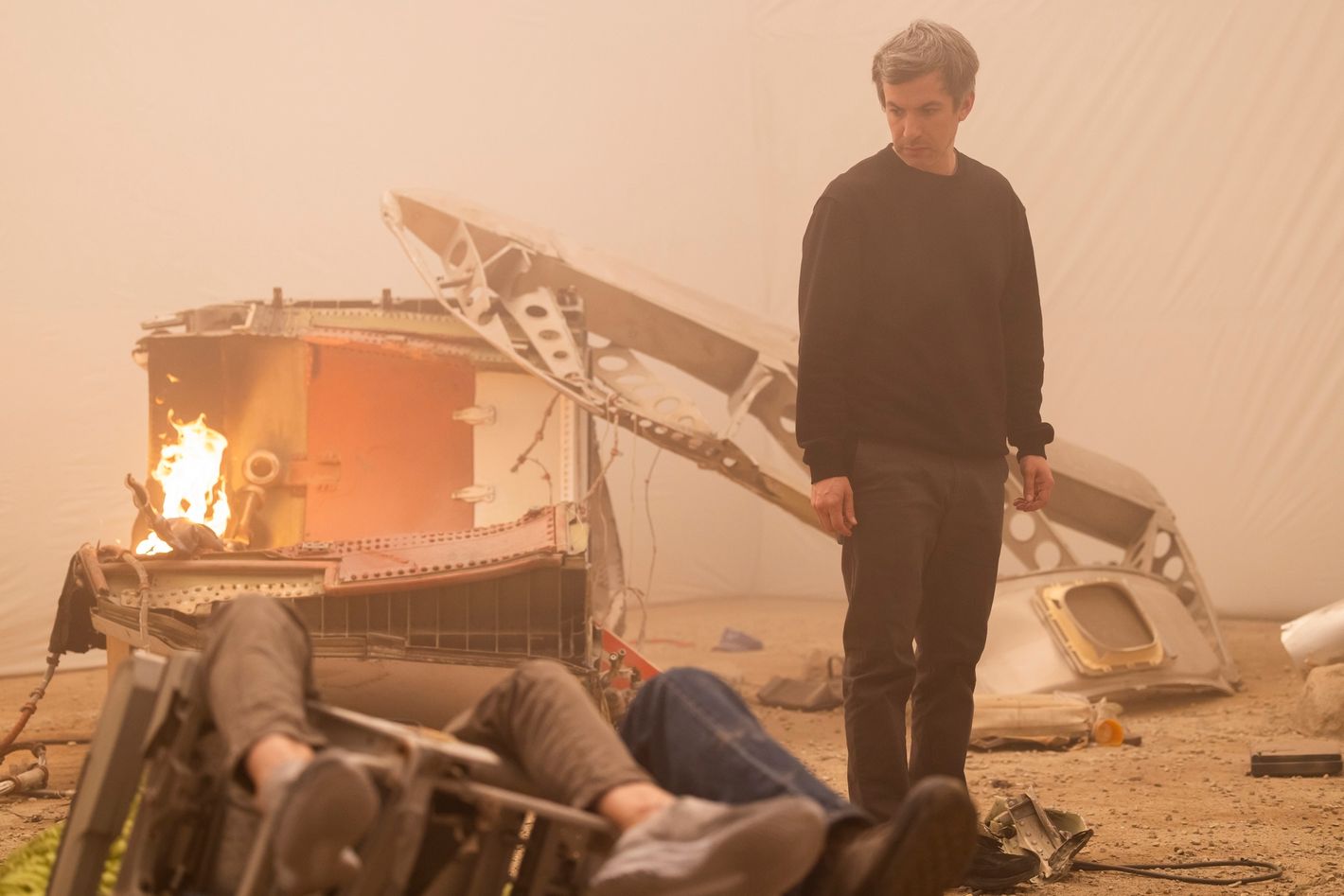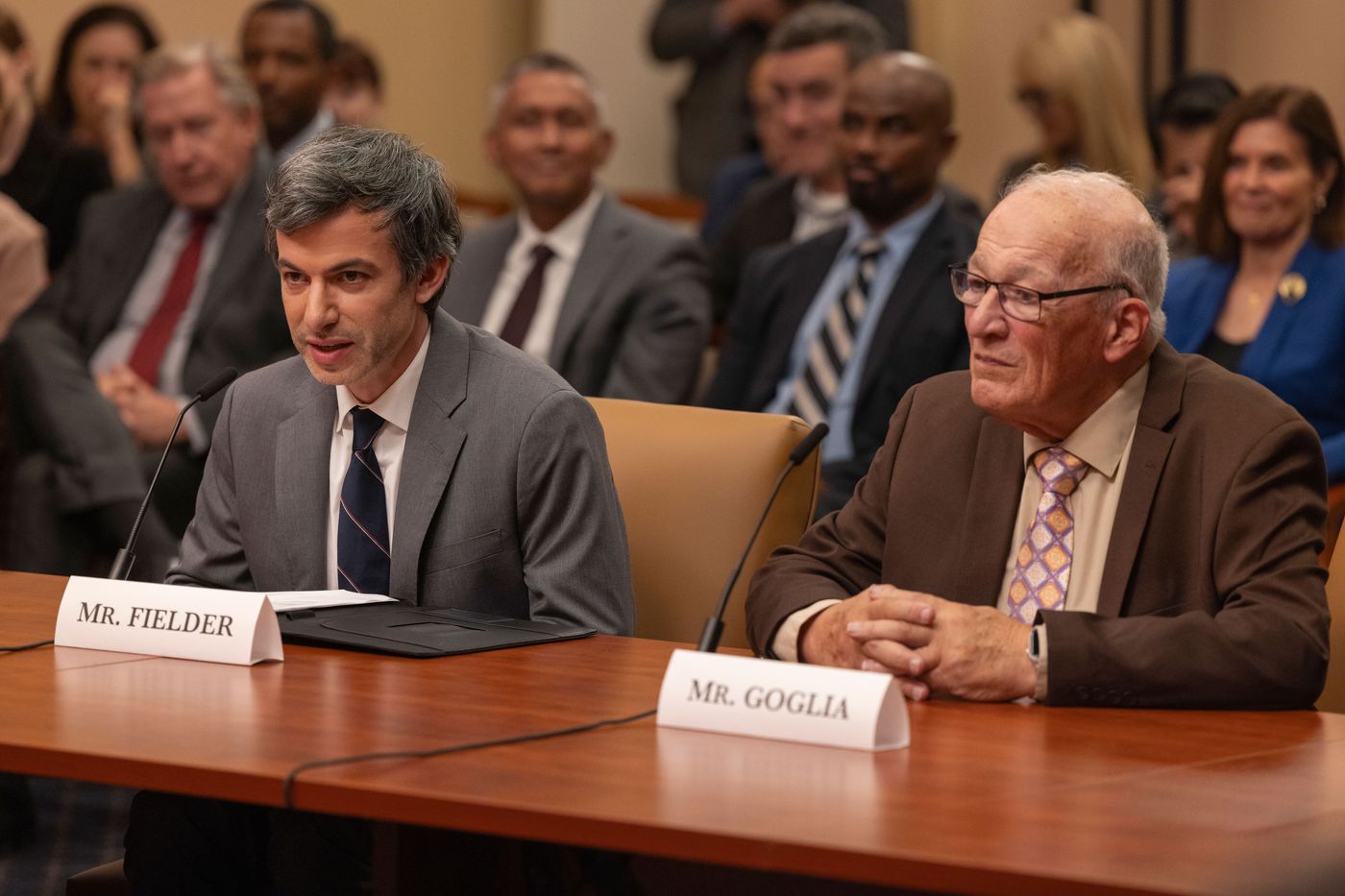Can Nathan Fielder Save You From Dying in a Plane Crash?


The early moments of the season-two premiere of The Rehearsal are not the stuff of conventional comedy. The episode, titled “Gotta Have Fun,” opens on a captain and first officer in the cockpit of a commercial jet as they prepare to land at a socked-in airport. The mood is tense. An instrument is malfunctioning. Terse words are exchanged. Alarms go off. A mechanical voice calls out: “Too low! Terrain!” Farm fields appear out of the fog. Noise and tumult. Flames leap and roar. The men lie slumped in the cockpit, dead.
Well, not really dead, because the scene is taking place in a simulator. The pilots are actors, pretending. The camera pans to Nathan Fielder, the show’s creator and star, as he glumly stands outside the cockpit in a soundstage.
Again, it’s not the stuff of conventional comedy, but Fielder is not a conventional comedian. In his breakout series Nathan for You, which ran for four seasons on Comedy Central, and season one of The Rehearsal on HBO, Fielder specialized in tackling real-world problems in the most obtuse and elaborate ways possible, with the extravagance of the solution often dwarfing the scale of the problem. In season one of The Rehearsal, he built a complete replica of Brooklyn’s Alligator Lounge, accurate down to the order of the spices in a tabletop spice rack, in order to help a trivia-night participant come clean about his educational status to a teammate. The humor, if you get it — not everyone does — springs from Fielder’s near-pathological level of commitment to increasingly absurd bits. But this time around, the stakes are not small. As a journalist who writes often about aviation safety, I’m acutely aware of just how real and widespread deadly air crashes are. What if, for once, the extravagance of Fielder’s solutions matched the scale of the problem?
Fielder begins this season of The Rehearsal by identifying what he says is a dangerous blind spot in aviation culture: pilots’ inability to communicate in crisis, as demonstrated in the opening scene and in a number of other re-created real-world crashes. And Fielder has an idea for how to fix the problem involving the very technique of re-creating and rehearsing that he developed in the show’s first season. In the season-two premiere, Fielder meets up with John Goglia, a former member of the National Transportation Safety Board, and shows him the text of a NTSB report on a 2009 crash advising the FAA that “role-playing or simulator-based exercises that teach first officers to assertively voice their concerns” should be required in pilot training. The FAA declined to adopt the proposal. “For whatever reason, they’re just not going there,” Goglia tells Fielder. Fielder proposes that, with the financial resources and platform that HBO provides him, he could revive the idea and “potentially solve this life-or-death issue and save real humans from dying.”
My first reaction to Fielder’s project was skepticism. Aviation is a vast and complex industry that employs a lot of very smart and serious people to think deeply about every conceivable safety topic. This is a show that involves Fielder dressed as an infant Sully getting his diaper changed by a giant mom puppet. It defies reason to expect that a premium-cable comedy series could have anything substantive to say about hazard mitigation. But then I started talking to experts in the field.

“For the first five minutes after I started watching it, I was just stunned. It’s a strange thing to admit, but I got a bit emotional,” Mark Noort told me shortly after the first episode aired. Noort is a professor of organizational psychology at Leiden University in the Netherlands who’s researched the exact kind of cockpit-communication issues that Fielder has latched on to. “Those opening scenes where they reenact a few crash transcripts — these were transcripts I remember reading and analyzing. Someone was making the effort to demonstrate how they actually looked. It really struck a nerve.”
Noort’s field, crew-resource management, or CRM, studies how people can work together effectively in critical safety settings like airline cockpits and surgical suites. CRM gained momentum in the wake of history’s deadliest aviation accident, the 1977 collision between two heavily laden 747s on the runway at Tenerife in the Canary Islands. A major contributing factor was the failure of one plane’s first officer to warn his captain, as they started their takeoff roll, that the other jet was still on the runway.
Within the field of CRM, the term “safety voice” refers to people’s willingness to speak up when they perceive that, as Noort puts it, “the shit is about to hit the fan.” In one 2021 study, Noort and his colleagues sifted through six decades’ worth of cockpit-voice-recorder transcripts from fatal crashes, looking for instances where subordinates spoke up to alert the captain to an imminent danger. Based on his work, Noort estimates that anywhere from a quarter to a half of all fatal crashes involve a failure of communication between aircraft crew.
The study of safety voice is a small field — Noort says “you can count the number of experts on the fingers of your hands” — so he was particularly impressed that Fielder zeros in on it so effectively. “What he has done is not only identify an issue that a few experts like myself and others in the field know about,” Noort says, “but he’s actually highlighting the approaches we have identified as being potentially beneficial.”
When I talked to airline pilots of my acquaintance, they confirmed that miscommunication in the cockpit has been a persistent problem. Rick Solan, a retired 777 captain, told me about the time about seven years ago when he was riding in a jump seat of a 777 that was about to take off from Tokyo on a transpacific flight with multiple copilots. As the plane lined up on a runway, there was a light tailwind, which increased the amount of runway the plane would need to take off. When the captain announced that he intended to take off at reduced power settings on the engines, the first officer protested that they would need more power. The captain overruled him, but the first officer persisted. Even as the plane began its takeoff roll, the first officer insisted that the reduced power setting was not only dangerous but illegal. “The captain just takes his flight-chart book and flings it right at the guy, hits the guy in the head, and goes back to flying,” Solan remembers. “The airplane takes off, gets to 10,000 feet, he points at the guy and goes, ‘Get the fuck out of my cockpit, and I don’t want to see you again.’”
As the principles of CRM have spread throughout the industry, that kind of dynamic has become increasingly rare in the cockpit. “The style of communication has changed,” Noort says. “We either filter out the cowboy mentality, or we train it away.”
One incident from 2022 illustrates how far the aviation industry has come. An Alaska Airlines flight from Washington to San Francisco was taxiing to take off when the captain and first officer got into an argument and refused to fly together. The plane returned to the gate, and the flight was delayed as the airline tracked down a replacement pilot. While the passengers were outraged, the airline was supportive of the flight crew’s decision. “While this situation was unfortunate, in the interest of safety, the pilots did the right thing,” Alaska said in a statement to Fox Business.
If Fielder is pulling a misdirection, it’s to imply that no one else has recognized the problem before or taken steps to mitigate it. But in much of the world, the kind of training that he’s proposing is already mandated. European regulators require trainee airline pilots to take a course in what’s called “multi-crew cooperation,” or MCC, after learning how to fly in a single-pilot cockpit. “They’ve never flown with another pilot,” says Pete Legg, head of training at CRM Aviation Europe, a flight school in England. “So then they take the MCC course, which is about how two pilots work together: How do you communicate? How do you work as a team?” The course includes 20 hours of classroom study and 40 hours in a simulator, where students go through just the kind of exercises that Fielder calls for. “It’s so important to live the experience, to know how it feels in an actual situation,” Noort says. “So you’re actually able to do it rather than tell someone about it.”
Back when Legg was flying as an airline captain, he applied the lessons of safety voice before every flight. Just before pulling away from the gate, he would give his first officer a departure briefing. “I would say, ‘I’m a very experienced captain. However, if at any time you see me doing anything that you don’t understand or you have concerns about, I want you to tell me,’” Legg says. “‘If something goes wrong, we die together, so if you see anything at any point that you don’t like, I want you to tell me about it.’”
Unfortunately, the degree to which Europe recognizes and addresses the problem is not matched in the United States, where CRM is mostly discussed in a classroom setting. “The aviation industry still doesn’t train this effectively,” Kimberly Perkins, an airline pilot and safety researcher who has studied safety voice, told me via email. “Even when CRM is taught, pilots often don’t retain it due to outdated syllabi, methodologies, and delivery modes. To truly shift this, we need modernized approaches” — including, she says, “immersive tech like VR and role-play scenarios.”

Let’s grant that Fielder has identified a real safety issue that could save human lives. And let’s grant that the approach he adopts in the show is an effective way to address the problem that has been proven successful in other countries but hasn’t been adopted here. Let’s even go so far as to stipulate that, by using a comedy show to draw the public’s attention to an otherwise arcane issue, Fielder may be vastly more effective at moving the ball on the issue than any scientific paper or public-awareness campaign possibly could be. That still leaves a major question: Are there really lives to be saved?
At the time Fielder started putting this season together, there hadn’t been a fatal airline crash in the United States in over a decade — not just involving safety voice but any from any cause at all. As someone who writes a lot about aviation safety, I’m often asked if it’s safe to fly, and I’ve reached for that factoid so many times that it’s become a habit. Planes don’t crash anymore. So when I watched Fielder claim in the first episode that lives were at stake, my first reaction was: But there are no lives at stake, because flying is already so safe.
But then I remembered what had happened in Washington, D.C., just a few months before. On the night of January 29, an Army Blackhawk helicopter on a training mission over the Potomac was flying south along the eastern shore of the river as it neared Reagan National airport. Air-traffic control radioed its crew to say that an inbound passenger jet was heading their way and would pass low over their route. The helicopter’s co-pilot, who was the instructor on this mission, radioed that he had the other aircraft in sight. The trainee pilot at the controls, meanwhile, had drifted laterally out of the assigned aerial route’s boundaries and climbed above its vertical limit. The instructor told the trainee to move to the left back toward the riverbank, which would have taken it out of danger. But she didn’t listen. She didn’t turn eastward, and she didn’t reduce her altitude. Fifteen seconds later, the Blackhawk collided with the inbound passenger jet at an altitude of about 300, sending both plummeting into the river and killing all 67 people aboard the two aircraft.
It’s an uncanny coincidence that, less than three months before the debut of a TV series about the dangers of poor cockpit communication, the U.S. should suffer its first fatal air crash in 16 years as a result of just such a failure. But given the prevalence of safety voice as a factor in fatal crashes overall, the odds are good that it will play a role in the next one too.
Unless Fielder’s advocacy actually works.
Related

Latest News
For Sale! 2016 Sea Ray 350 Sundancer – $180,000
Reel Deal Yacht is pleased to feature a meticulously maintained 2016 Sea...
Caitlin Tracey’s Remains Discovered in Luxury Chicago Condo, Found ‘Pulverized’
Tragic Death of Chicago Tech Executive Caitlin Tracey: A Fight for Justice...
2025 NBA Playoffs Schedule: Today’s Games and Complete Bracket with Conference Finals Matchups Confirmed
2025 NBA Playoffs: Conference Finals Preview The 2025 NBA playoffs have reached...
Pacers-Knicks renew a rivalry with memorable moments involving Reggie Miller, Spike Lee and others
The Indiana Pacers and New York Knicks have faced each other eight...
Canada coach Jesse Marsch understands why some fans may not want to travel to US for Gold Cup
Canada coach Jesse Marsch understands some of his team’s supporters might not...













Leave a comment